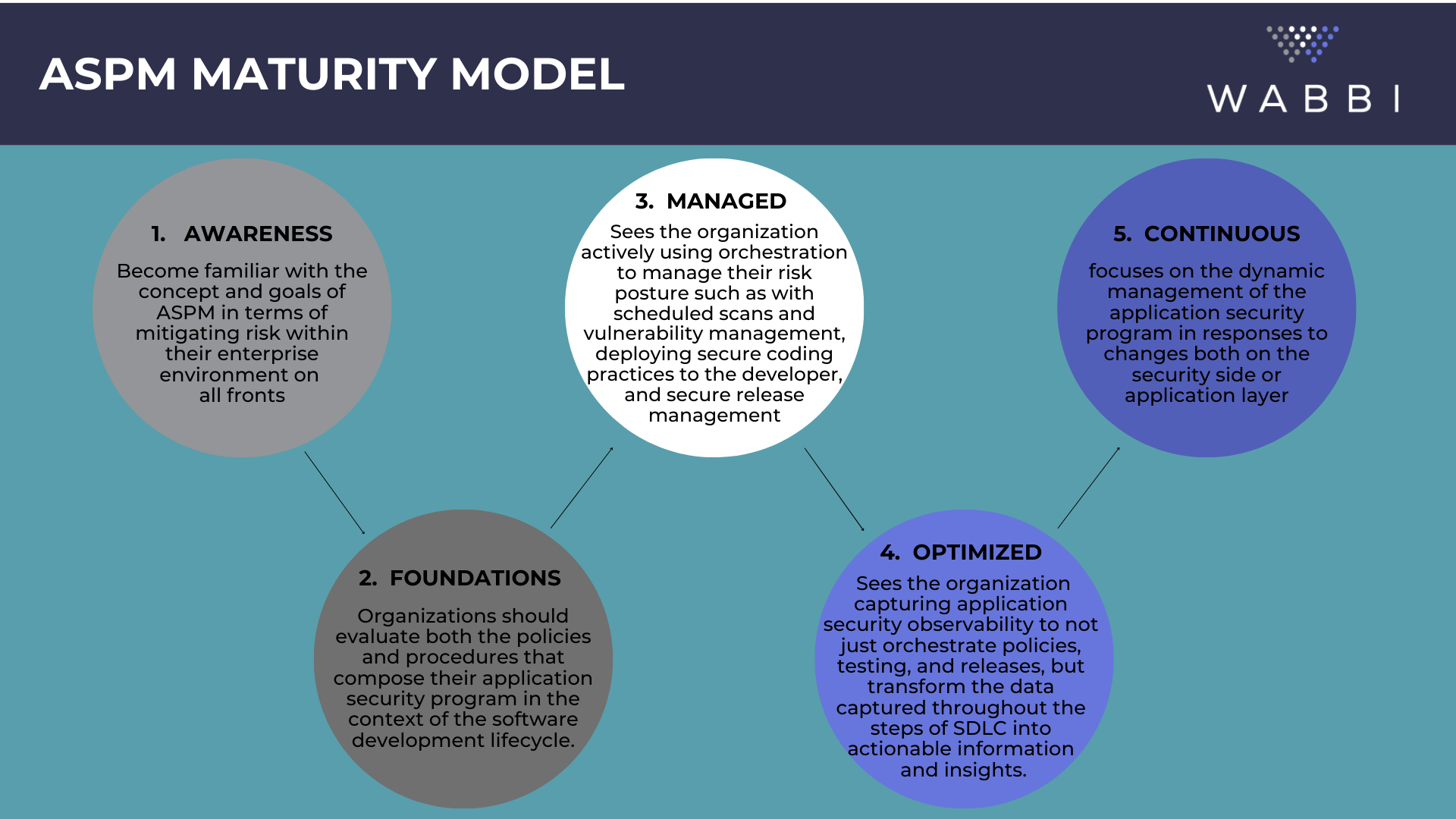Team Wabbi
June 5, 2023
Today, application security is more important than ever. Security risks and threats are constantly evolving, and organizations need to be able to quickly identify, prioritize, and mitigate them in order to stay ahead of the game. Application Security Posture Management (ASPM) is an essential tool for DevSecOps teams that provides visibility into their application security program, enabling them to create more secure development pipelines.
In this article we will:
- Explore what ASPM is and its major benefits
- Understand how ASPM enables both Security and Development teams to stay on top of security issues and requirements
- How you can implement ASPM in your organization as part of your DevSecOps initiative
- Why leveraging ASPM is key for strengthening your overall security posture.
What is application security posture management?
Application Security Posture Management (ASPM) is the practice of monitoring and managing an organization’s application security program. It is based on the principles of continuous security, which incorporates security testing and analysis into the development process. This helps to ensure that applications have the necessary security measures in place before they are deployed.
The goal of ASPM is to reduce the risk of application-level vulnerabilities across the organization. There are a variety of tools and techniques that can be used to implement ASPM, such as static and dynamic application testing, configuration scanning, and vulnerability scanning. Static application testing involves reviewing code for potential vulnerabilities prior to deployment, while dynamic application testing occurs during runtime. Configuration scanning checks for misconfigurations that could lead to weaknesses in system security, while vulnerability scanning looks for known threats in systems or networks.
By leveraging ASPM, DevSecOps teams can quickly identify any potential threats or risks associated with their applications and take immediate action to mitigate them. This helps organizations stay ahead of any emerging threats, secure their data, and protect their customers’ information from attackers. Moreover, incorporating ASPM into DevSecOps ensures that all applications released by an organization are secure and compliant with industry standards.
What are the benefits of ASPM?
Application Security Posture Management (ASPM) provides organizations with a host of advantages, ranging from enhanced visibility to greater security. By utilizing ASPM, businesses can gain an understanding of their application security posture, allowing them to more effectively identify and prioritize risks. This helps teams create secure development pipelines by quickly responding to any issues before they become serious problems.
Moreover, monitoring app security posture efficiently reduces the possibility of cyberattacks and data breaches. Having such a system in place enables companies to stay one step ahead of potential threats and bolster their overall security posture. This is especially critical for entities dealing with confidential customer data or executing financial transactions since other stakeholders may take on responsibility for data breaches that occur.
As DevSecOps teams strive for high-quality applications throughout their development lifecycle, ASPM can serve as a great foundation for success. It allows teams to proactively monitor their apps for vulnerabilities and recognize weaknesses prior to attackers doing so. Taking advantage of this tool means organizations can feel confident that their applications are safe against malicious actors and cyberattacks alike.
Finally, using ASPM enables companies to swiftly pinpoint domains needing additional training and devise effective strategies accordingly. This includes providing personnel with up-to-date instructions on how to handle sensitive customer information or execute best practices when addressing customer inquiries or resolving complex dilemmas. In addition, it allows them to analyze trends over time in order to enhance employee performance as well as gain insight into customer satisfaction levels and how they’re being impacted by changes made within the organization.
In summary, Application Security Posture Management presents countless benefits for organizations looking to remain ahead of emerging threats while boosting their overall security stance at the same time. With its capabilities giving teams transparency into their application security posture along with quick responses when needed, it has become an invaluable tool for modern businesses seeking optimal protection from cyberattacks and malicious actors while providing customers the best possible service.
How does ASPM enable DevSecOps?
In short, ASPM enables DevSecOps teams to detect and remediate security issues quickly, while providing organizations with actionable insights on how to strengthen their overall security posture. It also provides analytics that can be leveraged to improve processes and meet customer expectations for quality service. Ultimately, ASPM is an invaluable tool in helping companies protect themselves from cyber threats while ensuring customers receive the best possible service levels.
How to implement ASPM in your organization
Organizations looking to implement Application Security Posture Management (ASPM) must first define their desired security posture. This means mapping out the policies, processes and technologies that must be in place in order for their applications to remain secure. Once this is done, it’s time to identify the application security methods and tools necessary to achieve this posture. Depending on the size and complexity of the organization, these can range from static and dynamic application testing, configuration scanning, vulnerability scanning, code review and more.
Once the methods and tools have been identified, organizations need to develop an implementation plan for deploying them. This should include a timeline of when each element will be implemented as well as clear goals for each step. It’s also important to ensure that all personnel involved understand what is expected of them in order for ASPM implementation to run smoothly.
Once ASPM has been successfully implemented, organizations must continue to monitor and maintain their application security posture on an ongoing basis. This includes regular scans and audits of applications as well as updating policies and procedures as needed in order to remain compliant with industry standards. Additionally, personnel should be regularly trained on best practices for using ASPM tools in order to keep up with any changes or new threats that could arise over time.
By following these steps outlined above, organizations can ensure that their applications are secure and their security posture is maintained at all times. This helps protect against cyberattacks while providing customers with a safe experience when interacting with their services or products online. Ultimately, implementing Application Security Posture Management is an essential part of DevSecOps which allows companies stay one step ahead of potential threats while bolstering their overall security posture.
Conclusion: Leverage ASPM to strengthen your application security posture
In summary, Application Security Posture Management (ASPM) is an invaluable tool for organizations looking to stay on top of their application security posture. By utilizing an ASPM solution, organizations can gain greater visibility into their security posture and proactively manage any risks they identify. Additionally, it provides analytics to improve processes and meet customer expectations while eliminating blind spots and helping businesses remain competitive in the ever-evolving landscape. For this reason, leveraging ASPM is a critical step that all organizations must take in order to ensure secure applications and success in the marketplace.
Want to learn more about how you can integrate AppSec in your Development pipeline?
Check out these top resources!




Related Articles

Why Process Must Come Before Products in DevSecOps
Why Process Must Come Before Products in DevSecOps One foundational principle that’s often overlooked in the race to adopt DevSecOps is prioritizing process over products. While many organizations focus on selecting the right tools, The real key to DevSecOps success...

Bridging Cybersecurity and Innovation
Click below to listen to this episode of Strategy Next, where host Jon Lobb sits down with Brittany Greenfield, founder and CEO of Wabbi, to discuss the critical role of foundational security practices, and how organizations can navigate the balance between innovation...

The Hidden Risks: Internal Failures in Security by Design
The Hidden Risks: Internal Failures in Security by Design When we think about cybersecurity breaches, external attackers often come to mind—hackers, malware, and cybercriminals targeting organizations from the outside. However, breaches can also stem from within,...

DevSecOps in Digital Transformation
Click below to listen to this episode of Digital Shifts aka Corporate Evolution Tales, where host Mariam sits down with Brittany Greenfield, founder and CEO of Wabbi, to discuss how to align security with business goals, and why transformation is a continuous...

Tech Deep Dives: DevSecOps Secrets
Click below to listen to this episode of Kabir's Tech Dives, where host Kabir sits down with Brittany Greenfield, founder and CEO of Wabbi, to discuss how Wabbi is revolutionizing application security, the role of cybersecurity in development, and why modern...